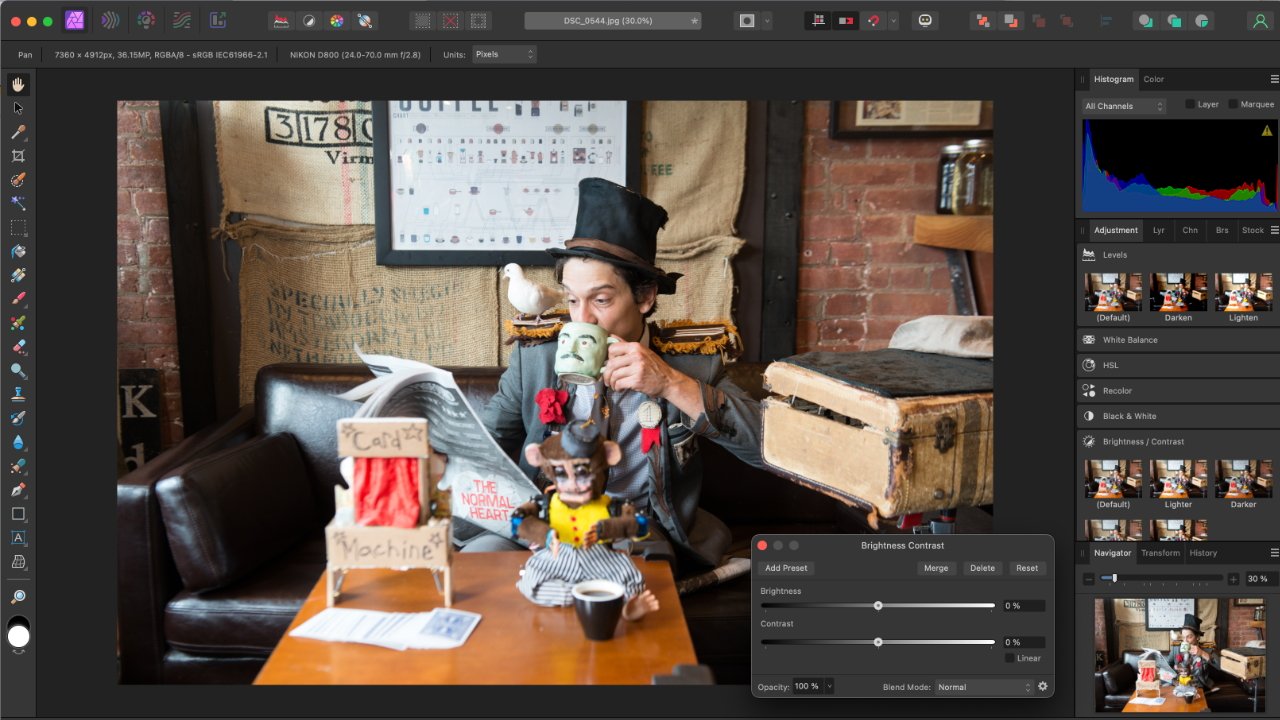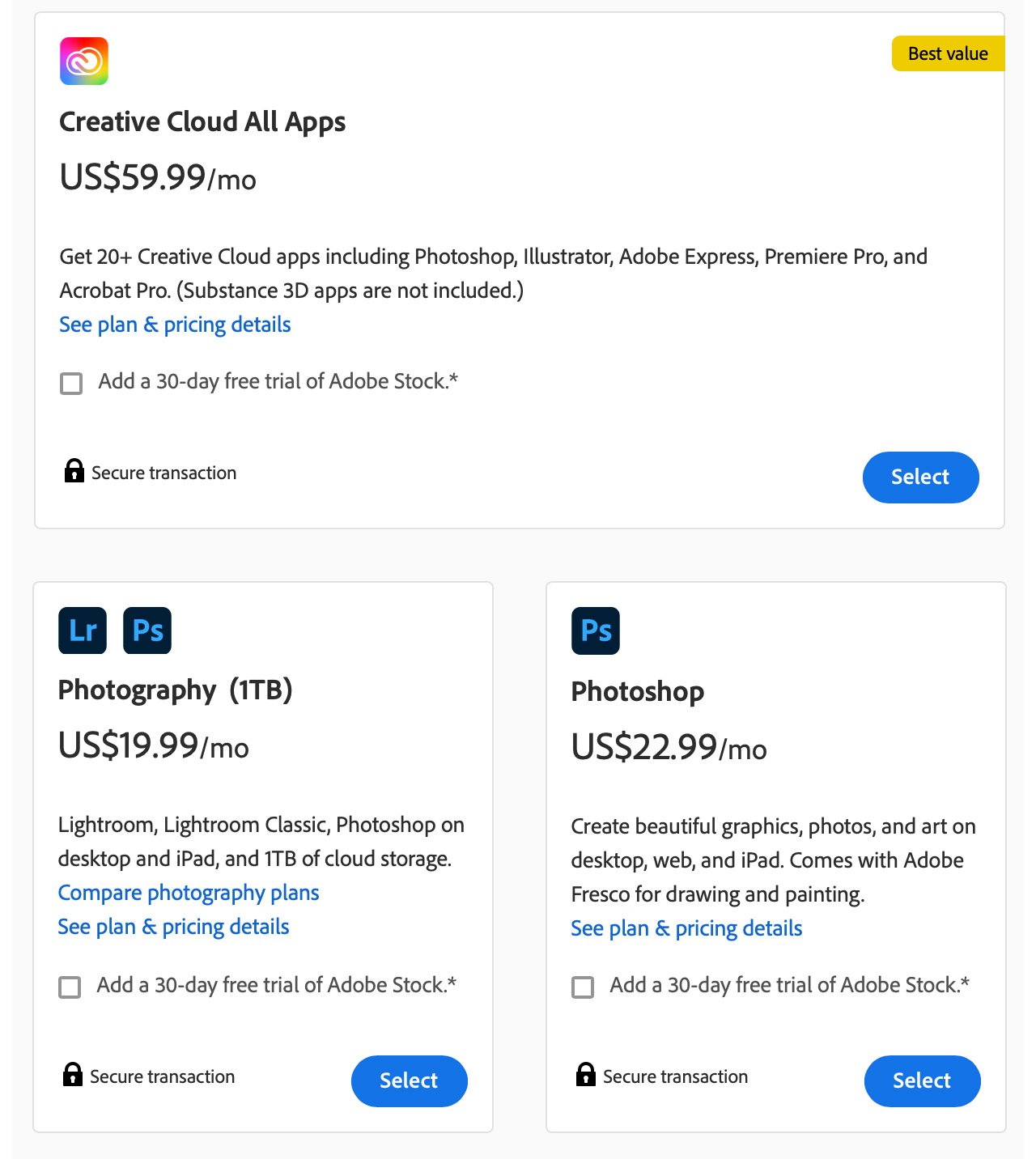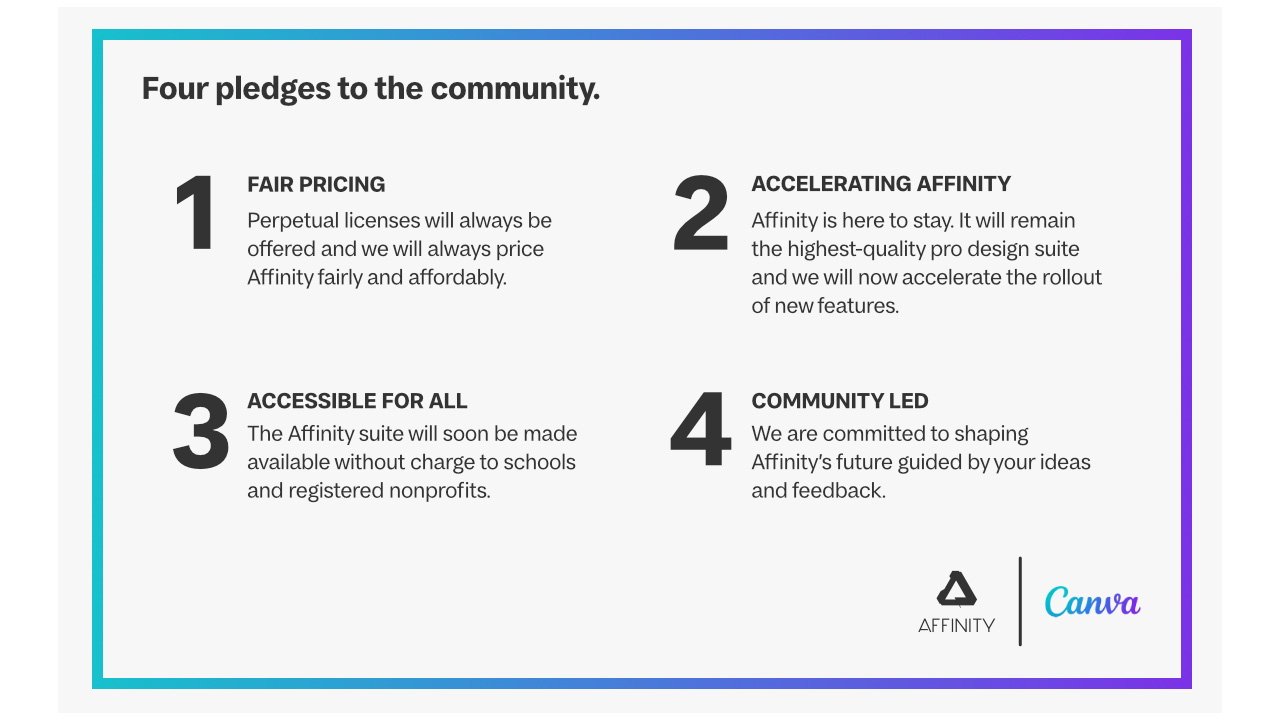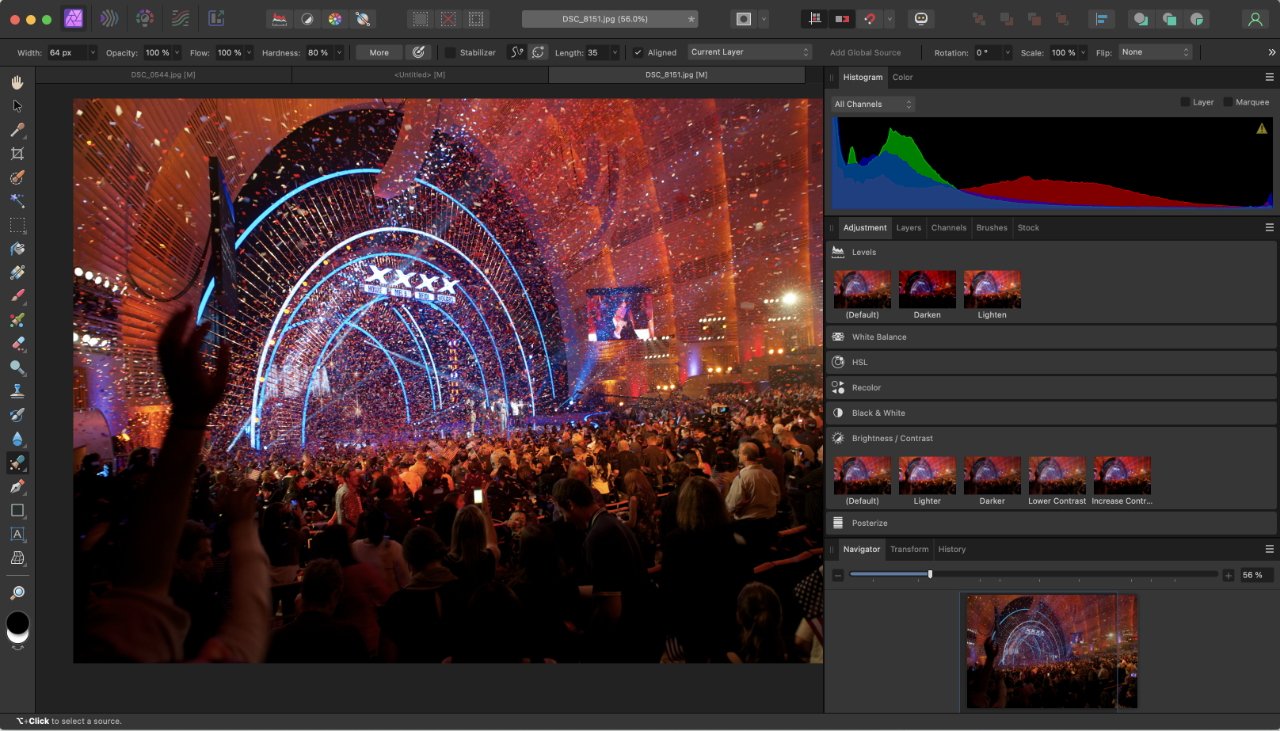Canva's Affinity deal will shake the Adobe status quo
Canva's recent acquisition of the company behind the Affinity line of photography and design tools will directly challenge Adobe's stranglehold on the market and subscription pricing model. Here's how, and why it's a good thing.

Affinity's design tools are known for their power and simplicity
By integrating Canva with Affinity, the company will leverage both its web-based offerings and stand-alone apps. Canva users will gain full-featured tools for the professional, while Affinity users will likely gain web-based AI-driven tools.
Affinity Photo, Affinity Designer, and Affinity Publisher are affordable choices for photographers and designers and are some of the few creator apps that offer perpetual licensing. The buy-once-and-use forever model was the norm in the design world, and Affinity is popular partially because it bucks the trend of monthly fees.
Power to the people
Canva was founded in 2013, and the need for quality graphics, logos, presentation templates, and other communication tools has fueled its growth to nearly 200 million users. As co-founder Cliff Obrecht puts it, "Canva has focused heavily on the 99% of knowledge workers without design training."
The web-based design tool leverages AI tools to help users design everything from YouTube banners to brochures to websites. Users can design projects from start to finish with just a few clicks. There was, until this announcement, no companion desktop tools from the company.
Canva exists solely as a web-based tool, without a desktop counterpart or at least a companion tool.

Adobe's pricing plans for its creative tools.
Subscription Fatigue
Affinity has evolved into a legitimate challenger to the Adobe throne. It has done this through a solid suite of features, paired with Adobe-inspired subscription fatigue.
For context, Microsoft dominated the word processing, spreadsheet, and presentation markets because of its ubiquity in the Office suite. Without a real alternative to its products, it was Office or nothing.
As Microsoft switched to subscription pricing for its suite of tools, users began to switch to alternatives.
Google finally disrupted Microsoft's office software market with its free Docs, Sheets, and Slides. For most users, the lack of cost for Google tools compensated for any features lacking in its solutions.
As a photographer and graphic designer, I have noticed many of my peers shifting away from Adobe's design and photography tools to Affinity for the same reasons. Microsft was a business case study in alienating customers with costly subscription plans and complex software. Now, Microsoft's legacy is a lesson that Adobe is learning.
Creative photographers and designers need powerful tools without steep learning curves or feature bloat. Affinity's photo, design, and page layout tools strike a nice balance between functionality and simplicity. They're less feature-packed than Adobe's offerings but are easier to navigate and lightning-fast. The power and performance make switching relatively painless.
The second, perhaps more important, factor for switching is Affinity's no-subscription price model. All three Affinity tools cost $164 for lifetime use, which is equal to eight months of a Photoshop subscription or three months of the full Creative Cloud subscription.
Doubling down
When Canva announced its purchase of Serif, users started worrying out loud in forums and on Reddit that the newly merged companies would change the flat-fee pricing model to a subscription one.

Canva and Affinity announced four pledges about their new integration and plans.
After launch, we contacted the Serif PR team and were assured that the pricing structure for Affinity would stay the same. They indicated they had heard users' complaints and were steadfast in their plans to keep buy-once, use-forever pricing.
Since then, the Canva and Affinity teams have released a statement outlining their plans and thoughts on the pricing models. They laid out four points they promised to adhere to.
In the statement, the newly combined teams said they would remain committed to fair pricing and perpetual licensing, resources would be put into Affinity to accelerate development, and the company would continue to use customer feedback to shape the product.
With its updates about pricing plans and perpetual licensing, the statement also said that Affinity will soon be made free to schools and not for profits. For cash-strapped educational institutions, this will undoubtedly drive many schools to use Affinity over Adobe Creative Cloud.
This last point is important considering Adobe's history in the design space. When I was in art school in the '90s, Adobe's suite was free or actively pirated with no repercussions.
Years later, as a journalist at an Adobe event, I casually asked Adobe's PR representatives if Adobe knew about the widespread sharing of serial numbers among students and the use of cracked software.
While not an official statement from Adobe and not something I could verify, the representative said that Adobe had been aware of this and chose not to do anything about it. Adobe knew that the use of its tools by art students got the students invested in the products and made them more likely to use them in their careers.
And as it pertains to the pricing model promise, I've been on this beat a long time. Over that time, many companies promised to keep flat-rate pricing but later changed their plans. It's wise to take statements about a company's long-term plans with a grain of salt.
In the case of Affinity, the price structure is the primary "feature" that sets the software apart from Adobe's offerings, so (today) I'm more confident that the company will keep its promises.
Price discrepancy
Adobe's subscription-based software model has generated significant user opposition, but as the dominant player in the market, Adobe is free to charge whatever price it wants. A subscription to Adobe Photoshop and Lightroom costs $20 a month.
In stark contrast, Affinity Photo 2 can be purchased and used indefinitely for $69. That's not $69 a month or even a year-- it costs $69 to use it forever.
A license for all three Affinity apps (Affinity Designer 2, Affinity Photo 2, and Affinity Publisher 2) costs $165. That price unlocks the Mac, Windows, and iPad versions of all the programs. For Version 1 users, the upgrade to Version 2 is $124.
For most users, Canva is completely free. The Canva Pro plan is $15 per month when billed monthly and under $10 a month when billed annually.
The Pro account unlocks over 100 million stock photos, audio, videos, and graphics. It also offers users more than 20 AI-driven tools, translation abilities, 1TB of storage, and 24/7 customer support, more than Adobe Express, a web-based tool like Canva.
Adobe Express isn't included with Creative Cloud and tacks more than $100 onto any Creative Cloud plan.
The best of both worlds?
With the acquisition of Serif, Canva suddenly has an ecosystem. The Canva website will likely continue to serve users with no design experience, and Serif's Affinity apps will attract higher-end users.
The interaction possibilities between the web suite and the app suite are interesting. I'm certain we'll be able to begin a design in Canva, and the online designs will automatically be available to Affinity. For example, you could make a quick brochure in Canva and open it in Affinity Designer 2.
Likewise, photo editors can edit in Affinity Photo 2 and then share their images with Canva users to integrate into a project. The connection between web and app tools may be transformative.
Even though I have a design and photography background, I use Canva quite a bit when I need a fast, well-composed design. To include my photo or design assets in Canva projects, I must export them from Adobe tools and upload them into Canva.
Integrating full-featured photo and design tools into Canva layouts would save significant time.
Canva also invests in AI-based tools, which will certainly come to Affinity in one way or another. Users might round trip to Canva for cloud-driven AI editing, or the AI toolset will be rolled into Affinity directly.

Affinity's apps match most of the features of Adobe's counterparts.
Cutting the cord
Because of this announcement, I will be downgrading from the full Creative Cloud plan to the $9.99 photography-only tools.
Reinforcing that point, while writing this piece, I received my monthly $60 bill from Adobe for Creative Cloud. I just need more time to jump ship from Adobe.
Adobe Illustrator and InDesign are the two tools that made me subscribe to the full plan instead of photo-only, and Affinity's tools are powerful enough to handle anything I would normally do with those two tools.
I don't know what I'll do with the $480 I'll be saving annually, but that's a lot of money to be able to dedicate to other needs. With any luck. those other things won't be subscription-based, though.
Read on AppleInsider

Comments
Less than one hour of freelance time pays for the power and Dozens of apps/services I receive with my Creative Cloud subscription each month.
Adobe is the industry standard and is comparatively cheaper than back when you bought upgrades each year or so for each separate application.
Nobody looks at your resume and says, "Oh, Wow! They use Canva!"
with the affinity purchase, it changes a little bit. Actual design creation tools that can be mashed up and Lego-d together in canva. That’s fairly compelling for anyone who isn’t already proficient in Adobe.
very interesting.
They might want to look at something like PeakTo
I just upgraded my Affinity licenses to 2.4.x so I'm feeling comfortable that i'll get enough mileage out of them before 3.0 comes and changes things up a bit.
Subscription coming up 2.0 will be my last Affinity products. EU and DOJ how many subscriptions can a citizen have?
I have Apple TV, Netflix, BritBox, and PBS there will be no more after them.
Serif who made Affinity is only 90 people and they have 3 million users. $18 iPad, $70 Mac, $165 for the Suite. Their reported yearly revenue was $60m in 2022, roughly 1m sales per year.
Canva is a subscription company with 170 million users, 3500 employees, $2 billion revenue/year.
Serif = $60m per year standalone purchases, no cloud services
vs
Canva = $2b per year subscription with cloud services
Adobe revenue is $19b per year and they have 30,000 employees, 10x the size of Canva
Standalone software is great in the short-term but after the sales dry up, the company still has to pay staff and when a big new development comes along like AI, they can't adapt quickly enough because they don't have the staff to do it.
With the operating costs of the Serif team, there won't be an immediate need to make their products subscription based but Canva has AI features and cloud services that require recurring revenue so if they integrate them, those features will need a subscription.
None of the products from Adobe, Canva or Serif are expensive when they are used for business.
Pixelmator Pro is still a lifetime purchase. I bought it years ago. I still do, with no subscription. Pixelmator Photo, which is a different tool, is subscription-based, but can also be purchased outright for a perpetual license.
It's good to point to others that haven't kept their promises, but it doesn't affect what Canva may or may not do. Only time will tell there.
As someone that's used Photoshop since 1.0, I know that almost no one paid for the upgrade yearly. They'd wait until a version with some important new feature came out. I used the same version of Photoshop across all of art school.
Not sure what you mean about what people put Canva on their resume. You should be giving someone a portfolio as a designer. And this isn't about using Canva it's about Canva and Affinity.
After retiring, it no longer made sense for me to pay a monthly subscription to Adobe, so I decided to try the Affinity Photo and Designer software. That was a few years ago. I even upgraded to the 2.0 versions less than a year ago, setting myself up for more disappointment.
I wanted to love the Affinity products —I really did— hanging in there year after year and hoping for the addition of meaningful features. But no, everything accomplished so elegantly by Adobe was a jury-rigged workaround with Affinity. I came to the conclusion that Affinity simply gave up on making its software even moderately competitive with Adobe. With this recent announcement, I can speculate that Affinity was hanging around hoping to be acquired.
What an ugly mess of promises and potential.
This is simply not true. I have a Creative Cloud subscription and Adobe Express is included. I do not pay anything extra for this.
Furthermore, it used to be possible to work across different disciplines but with each now subject to subscription-pricing it is almost impossible to ...for example, I spent years invested in Cinema 4D but it was not my core speciality and now it's impossible to sustain that subscription alongside Adobe CC and others.
It is fine incentivising students to use certain tools, but with an uncertain job market, globally, how many of them can afford to maintain the software between graduating and finding the roles for which they studied.
I believe that these developers need to rethink their strategies to serve real-world employment circumstances as they evolve throughout one's lifecycle.
Could not agree more -- I work in prepress at an award-winning commercial printer, and Canva and Affinity are absolute garbage from an output perspective. Forget about consistent color management or any kind of proper output control. These apps may be fine for people creating basic websites or office newsletters they'll send to their laser printer, but if you're building important projects that are intended for high-quality output, stick to the professional apps. If you don't want to pay a subscription, you can still buy a perpetual license to QuarkXPress -- it may be a pain to use compared with InDesign, but it's still powerful software built for pros (but that said, just save yourself -- and me -- the hassle and pay Adobe).
Sounds like a EU, DOJ job.....
PLM (Product Lifecycle Management / MCAD) users are primarily split amongst Siemens (NX, SolidEdge), Dassault (CATIA, SolidWorks), PTC (Creo), and AutoDesk (Inventor Pro), the last of which is what I use daily.
Nobody serious uses AutoCAD for product development, although some use it in conjunction with MCAD. AutoCad is almost entirely driven by Civil engineering, plus residential design, but for the most part, building design is accomplished with AutoDesk Revit, which is a big player, but not a monopoly.